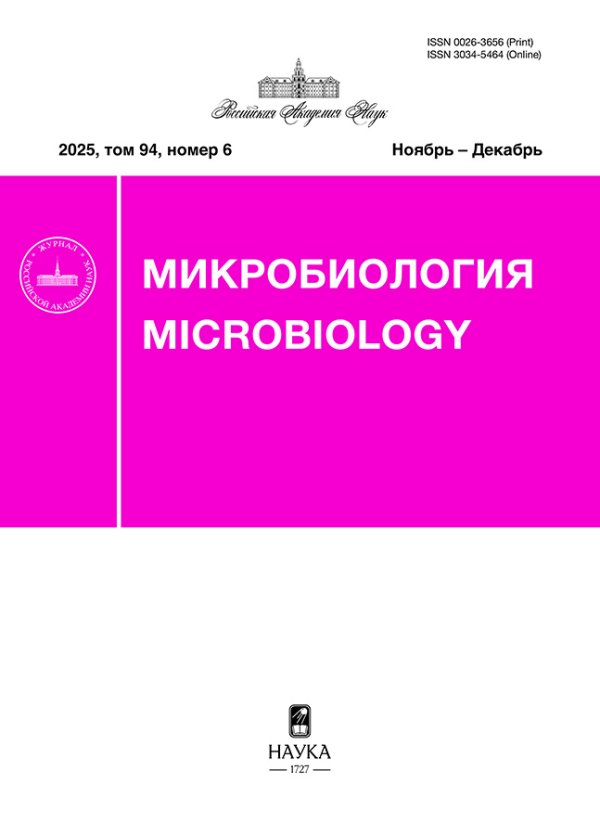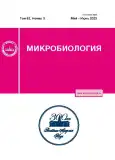Calcinating Bacteria in Extreme Ecosystems of the Southern Aral Region
- Authors: Kondrasheva K.V.1, Umruzokov A.A.1, Kalenov S.V.2, Merkel A.Y.3, Chernykh N.A.3, Slobodkin A.I.3, Gavrilov S.N.3, Davranov K.D.1
-
Affiliations:
- Institute of Microbiology, Uzbekistan Academy of Sciences
- Department of Biotechnology, Mendeleev University of Chemical Technology of Russia
- Winogradsky Institute of Microbiology, Research Center of Biotechnology, Russian Academy of Sciences
- Issue: Vol 92, No 3 (2023)
- Pages: 335-344
- Section: SHORT COMMUNICATIONS
- URL: https://journals.rcsi.science/0026-3656/article/view/138228
- DOI: https://doi.org/10.31857/S0026365622600869
- EDN: https://elibrary.ru/FWYKTA
- ID: 138228
Cite item
Full Text
Abstract
Abstract—
The processes of microbially induced precipitation of calcium carbonates are widespread in natural environments and are an important part of the biogeochemical carbon cycle. These processes comprised the basis of new “biocementation” technologies, which are extensively developing worldwide during the last decade. These technologies are aimed at the construction of novel “self-healing” construction materials, as well as at maintaining the strength of various buildings and structures. Since the optimal conditions for calcite formation are high salinity and alkalinity of the environment, the search for calcifying microorganisms in a variety of ecosystems, including extreme ones, is of interest. At present, many strains of halophilic and halotolerant bacteria, that induce calcination, have already been isolated and tested in pilot industrial processes. Most of these bacteria possess urease activity, which is the main contributor to the binding of calcium ions to insoluble calcium carbonate. A wide variety of natural ecosystems with optimal conditions for the development of calcifying urobacteria, as well as the economic demand for biocementation technologies, stimulate interest in the search for more and more novel strains of these microorganisms. One of the promising resources to be screened for such organisms is the ecosystem of the drying Aral Sea and the adjacent desert and semi-desert Aral region. Here we present the results of screening various extreme ecosystems of the Aral region for the presence of calcifying microorganisms. We obtained 28 pure cultures of heterotrophic aerobic bacteria from samples of plant residues and soils of the Aral Sea region, 4 of which had urease and calcifying activities. Their activities were compared with those of the strains presently used to produce biocementing mixtures. We have identified the phylotypes of putative calcifying microorganisms in microbial communities of desert soil, thermal waters, and bottom sediments of a salt lake, and described the phylogenetic diversity of these communities. Our results indicated the wide distribution of calcifying microorganisms in the ecosystems of the South Aral region and highlighted the expediency of screening them for the new biotechnologically relevant strains of these organisms.
About the authors
K. V. Kondrasheva
Institute of Microbiology, Uzbekistan Academy of Sciences
Email: sngavrilov@gmail.com
Uzbekistan, 100128, Tashkent
A. A. Umruzokov
Institute of Microbiology, Uzbekistan Academy of Sciences
Email: sngavrilov@gmail.com
Uzbekistan, 100128, Tashkent
S. V. Kalenov
Department of Biotechnology, Mendeleev University of Chemical Technology of Russia
Email: sngavrilov@gmail.com
Russia, 125480, Moscow
A. Yu. Merkel
Winogradsky Institute of Microbiology, Research Center of Biotechnology, Russian Academy of Sciences
Email: sngavrilov@gmail.com
Russia, 117312, Moscow
N. A. Chernykh
Winogradsky Institute of Microbiology, Research Center of Biotechnology, Russian Academy of Sciences
Email: sngavrilov@gmail.com
Russia, 117312, Moscow
A. I. Slobodkin
Winogradsky Institute of Microbiology, Research Center of Biotechnology, Russian Academy of Sciences
Email: sngavrilov@gmail.com
Russia, 117312, Moscow
S. N. Gavrilov
Winogradsky Institute of Microbiology, Research Center of Biotechnology, Russian Academy of Sciences
Author for correspondence.
Email: sngavrilov@gmail.com
Russia, 117312, Moscow
K. D. Davranov
Institute of Microbiology, Uzbekistan Academy of Sciences
Email: sngavrilov@gmail.com
Uzbekistan, 100128, Tashkent
References
- Батяновский Э.И., Гуриненко Н.С., Корсун А.М. Структура, непроницаемость и долговечность цементного бетона // Наука и техника. 2022. Т. 21. № 1. С. 19‒27.
- Гаврилов С.Н., Потапов Е.Г., Прокофьева М.И., Клюкина А.А., Меркель А.Ю., Маслов А.А., Заварзина Д.Г. Разнообразие новых некультивируемых прокариот в микробных сообществах минеральных подземных вод Ессентукского месторождения // Микробиология. 2022. Т. 91. С. 32–49.
- Gavrilov S.N., Prokof’eva M.I., Klyukina A.A., Merkel A.Y., Zavarzina D.G., Potapov E.G., Maslov A.A. Diversity of novel uncultured prokaryotes in microbial communities of the Yessentukskoye underground mineral water deposit // Microbiology (Moscow). 2022. V. 91. P. 28‒44.
- Давидюк А.А., Рыбнов Д.С., Гоглев И.Н., Соколов К.Ю., Кустикова Ю.О. Математическое моделирование динамики процесса массопереноса при коррозии цементных бетонов // Промышленное и гражданское строительство. 2021. № 2. С. 34‒41.
- Давлетмуратова В.Б. Развитие процессов опустынивания и галофитизация естественной растительности в дельте и низовьях Амударьи // Экономика и социум. 2017. Т. 37. № 6-1. С. 519‒522.
- Большое Аральское море в начале XXI в.: физика, биология, химия / Под ред. Завьялова П.О. и др. М.: Наука, 2012. 232 с.
- Калёнов С.В., Градова Н.Б., Сивков С.П., Агалакова Е.В., Белов А.А., Суясов Н.А., Хохлачёв Н.С., Панфилов В.И. Препарат на основе бактерий, выделенных из гиперсоленых сред, для улучшения функциональных и защитных характеристик бетона // Биотехнология. 2020. Т. 36. № 4. С. 21–28.
- Almajed A., Lateef M.A., Moghal A.A.B., Lemboye K. State-of-the-art review of the applicability and challenges of microbial-induced calcite precipitation (MICP) and enzyme-induced calcite precipitation (EICP) techniques for geotechnical and geoenvironmental applications // Crystals. 2021. V. 11. Art. 370.
- Alonso M.J.C., Ortiz C.E.L., Perez S.O.G. et al. Improved strength and durability of concrete through metabolic activity of ureolytic bacteria // Environ. Sci. Pollut. Res. 2018. V. 25. P. 21451−21458.
- Arias D., Cisternas L.A., Miranda C., Rivas M. Bioprospecting of ureolytic bacteria from Laguna Salada for biomineralization applications // Front. Bioeng. Biotechnol. 2019. V. 18. Art. 209.
- Atkinson D.E. Functional roles of urea synthesis in vertebrates // Physiol. Zool. 1992. V. 65. P. 243‒267.
- Chaparro-Acuña S.P., Becerra-Jiménez M.L., Martínez-Zambrano J.J., Rojas-Sarmiento H.A. Soil bacteria that precipitate calcium carbonate: Mechanism and applications of the process // Acta Agronomica. 2020. V. 67. P. 277–288.
- DeJong J.T. Biogeochemical processes and geotechnical applications: progress, opportunities and challenges // Geotechnique. 2013. V. 63. P. 287–301.
- Ekprasert J., Fongkaew I., Chainakun P. et al. Investigating mechanical properties and biocement application of Ca-CO3 precipitated by a newly-isolated Lysinibacillus sp. WH using artificial neural networks // Sci. Rep. 2020. V. 10. Art. 16137.
- Frankel R.B., Bazylinski D.A. Biologically induced mineralization by bacteria // Rev. Mineral. Geochem. 2003. V. 54. P. 95–114.
- Galinski E.A., Trüper H.G. Microbial behaviour in saltstressed ecosystems // FEMS Microbiol. Rev. 1994. V. 15. P. 95–108.
- Garabito M.J., Márquez M.C., Ventosa A. Halotolerant Bacillus diversity in hypersaline environments // Can. J. Microbiol. 1998. V. 44. P. 95‒102.
- Jebbar M. Ectoine functions as an osmoprotectant in Bacillus subtilis and is accumulated via the ABC-transport system OpuC // FEMS Microbiol. Lett. 1997. V. 154. P. 325–330.
- Joshi S., Goyal S., Mukherjee A., Reddy M.S. Microbial healing of cracks in concrete: a review // J. Ind. Microbiol. Biotechnol. 2017. V. 44. P. 1511‒1525.
- Joshi S., Goyal S., Reddy M.S. Influence of biogenic treatment in improving the durability properties of waste amended concrete: a review // Constr. Build. Mater. 2020. V. 263. Art. 120170.
- Kalenov S.V., Belov A.A., Lyapkin E.I., Sachavskii A.A., Panfilov V.I. Problems of non-sterile cultivation of extremely halophilic microorganisms // Int. Multidisc. Sci. GeoConference: SGEM. 2020. V. 20. P. 105‒112.
- Karplus P.A., Pearson M.A., Hausinger R.P. 70 years of crystalline urease: what have we learned? // Acc. Chem. Res. 1997. V. 30. P. 330–337.
- Leeprasert L., Chonudomkul D., Boonmak C. Biocalcifying potential of ureolytic bacteria isolated from soil for biocementation and material crack repair // Microorganisms. 2022. V. 10. Art. 963.
- Micklin P. The Aral Sea disaster // Annu. Rev. Earth Planet. Sci. 2007. V. 35. P. 47‒72.
- Mutitu K.D., Munyao M.O., Wachira M.J., Mwirichia R., Thiong’o K.J., Marangu M.J. Effects of biocementation on some properties of cement-based materials incorporating Bacillus species bacteria – a review // J. Sustain. Cem. 2019. V. 8. P. 309‒325.
- Omoregie A.I., Palombo E.A., Nissom P.M. Bioprecipitation of calcium carbonate mediated by ureolysis: a review // Environ. Engineer. Res. 2021. V. 26. Art. 200379.
- Osinubi K.J., Eberemu A.O., Ijimdiya T.S., Yakubu S.E., Gadzama E.W., Sani J.E., Yohanna P. Review of the use of microorganisms in geotechnical engineering applications // SN Applied Sciences. 2020. V. 2. № 2. P. 1‒19.
- Pacheco V.L., Bragagnolo L., Reginatto C. et al. Microbially induced calcite precipitation (MICP): review from an engineering perspective // Geotech. Geol. Eng. 2022. V. 40. P. 2379–2396.
- Panosyan H., Hakobyan A., Birkeland N.K., Trchounian A. Bacilli community of saline-alkaline soils from the Ararat Plain (Armenia) assessed by molecular and culture-based methods // Syst. Appl. Microbiol. 2018. V. 41. P. 232‒240.
- Vahabi A., Ramezanianpour A., Sharafi H., Zahiri H., Vali H., Noghabi K. Calcium carbonate precipitation by strain Bacillus licheniformis AK01, newly isolated from loamy soil: a promising alternative for sealing cement-based materials // J. Basic Microbiol. 2015. V. 55. P. 105‒111.
- Ventosa A., Márquez M.C., Garabito M.J., Arahal D.R. Moderately halophilic Gram-positive bacterial diversity in hypersaline environments // Extremophiles. 1998. V. 2. P. 297‒304.












